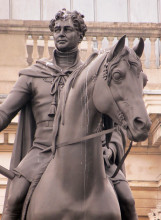
This is a second page showing equestrian statues in London with the horses in a variety of poses, for the interest of those who want model horses to draw from, and art historical interest. The first page is here. As previously, the photos show standard views of each horse, front, left, back and right, where this is possible, and on the second line for each horse are standard portraits of the horse's head from front, left and right. The lighting changes between pictures due to the direction and the time of day.
As usual, click on the pictures to enlarge and scrutinise closely; the pictures are somewhat larger than the norm for this site to aid drawing.
The order of sculptures shown is by date, with the earliest being Chantrey's George IV of 1828, but the majority being in the early 20th Century.
If you are only here for the drawing, and not particularly interested in sculpture, I would still encourage you to glance at some of the pictures of other Victorian and Edwardian sculptures scattered elsewhere on these pages - many with artistic inclinations start from looking at illustrations and paintings, and come late to an appreciation of sculpture. You may like the animals pages accessible from this page, and the page on sphinxes, and there is a page on sculptured hands for drawing.
George IV, Trafalgar Square, by Sir Francis Chantrey, 1828.
We start with George IV in Trafalgar Square, which being by Francis Chantrey, the most successful of all early 19th Century British sculptors, has a horse which is typically highly finished and a work of beauty. The long, curved neck, the care given to the locks of the mane, and the smooth flow of muscles under the skin show this as an elegant, thoroughbred beast. It is comparable and similar in pose to the other London horse by Chantrey, shown on the companion page to this, in the equestrian statue of Wellington, of some years later.
Prince Albert, Holborn Circus, by Charles Bacon, 1874.
The statue of Prince Albert at Holborn Circus is most lively, with the horse in frisky pose, and Albert raising his hat to some long-gone 19th Century audience. Alas, in recent years it has suffered from lack of a new coat of paint, so appears rather blotchy in the pictures. The treatment of the mane is not dissimilar to Chantrey's, but this is a much more active animal. Note especially the lowered ears, and the head bent so far down that the nose and jaw is less far forward than the forehead. The sculptor was Charles Bacon, a rather obscure figure who has no other public sculpture to his name of which I am aware.
Physical Energy, Kensington Gardens, by G. F. Watts, 1902.
The sculptural group entitled Physical Energy, standing towards the centre of Kensington Gardens, is of great use to the illustrator, stripping the horse to its essential masses, bones and sinews. The artist, G. F. Watts, was much better known as a painter than a sculptor, but produced several works of sculpture, each one of a kind, and each of great power. The surging forward and upward of the horse and the twist of its neck show the strain and power of the animal.
Duke of Cambridge, Whitehall, by Adrian Jones, 1907.
Adrian Jones, the sculptor of the Duke of Cambridge equestrian statue, was himself a horseman and his horses are always good. Another horse by him is shown here. This one, though, is a calmer beast, walking slowly forward, head down, ears up. Note the musculature of head and flank. It stands in Whitehall, meaning that I could not get the distance for the profile views to avoid looking upwards.
Viscount Wolseley, Horseguards Parade, by William Goscombe John, 1920.
The Viscount Wolseley statue on Horseguards Parade is by Goscombe John, a prolific sculptor who seems to have made much of the significant sculpture in Wales, and whose prolific output includes several equestrian portraits. His other London horse is shown here. In Wolseley's horse we have a rather symmetrical pose, the animal almost standing to attention. Like Chantrey's horses, we see here a well behaved thoroughbred. The modelling of the head is of particular note.
Marshal Foch, Grosvenor Place, by Victoria Station, by George Malissard, 1930.
Here we have, unusually, an equestrian sculpture in London by a French sculptor. The date with the signature is as late as 1930, so we are at a period where fine detail of mane, joints and muscles cannot be expected. However, a fine upper part to the head, and the rear knees also bear examination. The horse is stationary, but the forward thrust of the neck, particularly noticeable in the rightward-facing picture above, demonstrates an alert beast ready to move.
Earl Haig, Whitehall, by Alfred Hardiman, 1936.
Another odd one, from shortly before WW2 - the second equestrian statue in Whitehall. We are firmly into a modern idiom here, with the musculature reduced to simple, large masses. The odd stance of the rear legs and the tucked-down-and-in pose to the head attracted much criticism when the work was put up. A very different approach to the concept of the horse by the sculptor, Alfred Hardiman, excellent in its own way.
Visits to this page from 8 Jul 2013: 13,392
First page of London horse sculptures for drawing // sculptured hands for drawing //Sculpture of feet for drawing